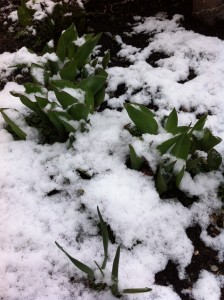All about tulips – hardy bulbs that area easy to grow in Seattle
Posted on March 9th, 2012 by Phuong

Tulips peeking through recent snow
Despite the snow in the Seattle recently, there are still signs of spring everywhere. Forsythia branches are showing their signature yellow color; flowering currants and magnolias are starting to bloom; and the most enjoyable, distinctive sign of spring – tulips – are emerging after a winter spent growing underground.
Tulips are native to central Asia and were first commercially cultivated as early as 1000 AD by the Turks, long before a botanist named Carlos Clusius widely introduced them to the Netherlands during the late 16th century. Tulips are now synonymous with the Netherlands, and regionally, with the Skagit Valley, where visitors can catch thousands of tulips blooming during the spring Tulip Festival (April 1-30, 2012).
Tulips are hardy bulbs and easy to grow in the Seattle area. They can withstand cold snaps without much problem; so no need to worry about the recent snowfall. Plant tulips and other spring-blooming bulbs, such as daffodils, in the fall so they can bloom in the spring. For the showiest blooms, buy the biggest bulbs and buy them as soon as you start seeing them in the garden store (avoid ones with roots growing from them). Tulips require a good dose of sun — about 5 to 6 hours a day — and well-drained soil. Plant them a few inches deeper than the packet instructions tell you, about 10 inches or so.

Ecoyards’ youngest employee with tulips, planted two years ago.
In the Ecoyards garden, our tulips are starting to peak out of the ground (pictured above) in early March. Some people plant tulips yearly for the best blooms and show, but most high-quality tulip bulbs will continue to bloom for three years with good results if you put them in a sunny spot with good drainage. (Check your bulb variety; some very showy blooms are sold as annuals and are only meant to bloom for one season). From year to year, tulips split into smaller bulbs, and eventually those smaller bulbs may not produce a flower. The tulips pictured here were planted about three seasons ago, so we will probably divide the bulbs later this fall or plant new ones.
Now is probably a good time give your bulbs a bit of fertilizer. You should fertilize as foliage (about an inch or two) emerges and again after flowering (there’s no need to fertilize if you’re treating the tulips as an annual, or good for one season). If you want to cut the flowers for indoor use, do it when it’s just past the tight bud stage. Cut it in the morning, put the stems in lots of water and store in a cool area.
Once a tulip has bloomed, remove the dead flower so it doesn’t set seed, which can reduce bulb growth. But resist the urge to pluck the leaves. Let the leaves get good and brown before removing them. The foliage is working hard to photosynthesize nutrients and to recharge the bulb so it can send up a healthy flower stalk next spring. Once the leaves are withered and brown, cut them back and leave the bulbs in the ground for next spring’s bloom.
Filed under:Seattle Landscape Design, Seattle Landscape Maintenance | Permalink |



